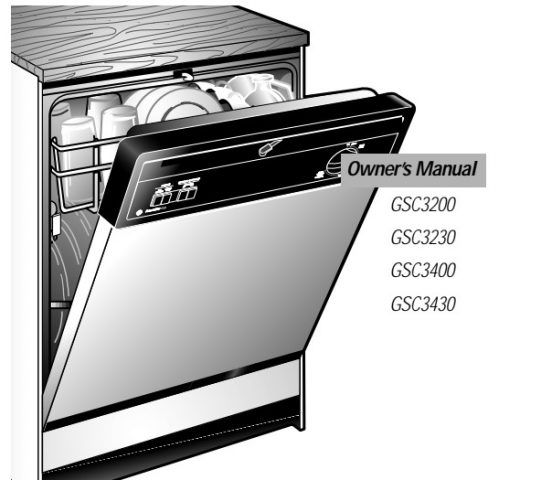Congratulations! You Are Now Part of the GEVFamily.
Welcome to the GE family. We’re proud of our quality products and we are committed to providing dependable service. You’ll see it in this easy-to-use Owner’s Manual and you’ll hear it in the friendly voices of our customer service department.
Best of all, you’ll experience these values each time you use your dishwasher. That’s important because your new dishwasher will be part of your family for many years. And we hope you will be part of ours for a long time to come.
We thank you for buying GE. We appreciate your purchase and hope you will continue to rely on us whenever you need quality appliances for your home.
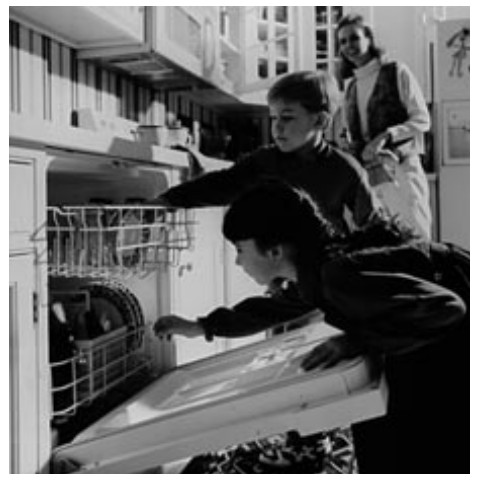
Fill out and return the Consumer Product Ownership Registration card that is packed with this product. If you cannot find it, please send in the duplicate card printed in the back of this manual.
You can find the model and serial number on the tub wall just inside the door. Staple sales slip or cancelled check here. Proof of the original purchase date is needed to obtain service under the warranty.
GE& You, A Service Partnership.
Ask any GE appliance owner and they will tell you we stand behind our products with unmatched quality service. However, did you know that most questions result from simple problems that you can easily fix yourself in just a few minutes? This Owner’s Manual can tell you how.
Read this Manual
Inside you will find many helpful hints on how to use and maintain your dishwasher properly. Just a little preventive care on your part can save you a great deal of time and money over the life of your dishwasher.
Review the Section on Troubleshooting Tips
You’ll find many answers to common problems here. If you review our chart of Troubleshooting Tips first, you may not need to call for service at all.
If You Need Service
If you do need service, you are a phone call away. A list of toll-free customer service numbers is included in the back section. Or you can always call the GE Answer Center® at 800.626.2000, 24 hours a day, 7 days a week.
Important Safety Information. Read All Instructions Before Using
For your safety, the information in this manual must be followed to minimize the risk of fir e, explosion, electric shock, or to prevent property damage, personal injury, or loss of life.
Water Heater Safety
Under certain conditions hydrogen gas may be produced in a water heater that has not been used for two weeks or more. HYDROGEN GAS IS EXPLOSIVE.
If the hot water has not been used for two weeks or more, prevent the possibility of damage or injury by turning on all hot water faucets and allow them to run for several minutes. Do this before using any electrical appliance which is connected to the hot water system. This simple procedure will allow any built-up hydrogen gas to escape. Since the gas is flammable, do not smoke or use an open flame or appliance during this process.
Use your dishwasher only for its intended purpose as described in this Owner’s Manual.
Proper Installation and Maintenance
- This dishwasher must be properly installed and located in accordance with the Installation Instructions before it is used. If you did not receive an Installation Instructions sheet with your dishwasher, you can receive one by calling us toll- free at the GE Answer Center®, 800.626.2000.
- Connect to a grounded metal, permanent wiring system; or run an equipment- grounding conductor with the circuit conductors and connect to the equipment- grounding terminal or lead of the appliance.
- Improper connection of the equipment-grounding conductor can result in a risk of electric shock. Check with a qualified electrician or service representative if you are in doubt whether the appliance is properly grounded.
- Dispose of discarded appliances and shipping or packing material properly.
- Do not attempt to repair or replace any part of your dishwasher unless it is specifically recommended in this manual. All other servicing should be referred to a qualified technician.
- To minimize the possibility of electric shock, disconnect this appliance from the power supply before attempting any maintenance. NOTE: Turning the dishwasher off does not disconnect the appliance from the power supply. We recommend having a qualified technician service your appliance
Do Not
- Do not tamper with controls.
- Do not abuse, sit on, or stand on the door or dish rack of the dishwasher.
- Do not discard a dishwasher without first removing the door of the washing compartment.
- Do not store or use combustible materials, gasoline or other flammable vapors and liquids in the vicinity of this or any other appliance.
- Do not allow children to play inside, on or with this appliance or any discarded
When Using Your Dishwasher…
- Use only powder or liquid detergents or wetting agents recommended for use in a dishwasher and keep them out of the reach of children.
- Locate sharp items so that they are not likely to damage the door seal.
- Load sharp knives with the handles up to reduce the risk of cut-type injuries.
- Do not wash plastic items unless marked dishwasher safe or the equivalent. For plastic items not so marked, check the manufacturer’s recommendations.
- Do not touch the heating element during or immediately after use.
- Do not operate your dishwasher unless all enclosure panels are properly in place.
- Close supervision is necessary if this appliance is used by or near children.
- Load light plastic items so they will not become dislodged and drop to the bottom of the dishwasher— they might come into contact with the heating element and be damaged.
Read these safety tips carefully and save them for future use
About the Unicouple
Before operating the dishwasher the First Time:
Attach the faucet adapter.
The special faucet adapter supplied with your dishwasher must be assembled to the sink faucet before you can use your dishwasher.
The faucet adapter is designed to fit standard spouts having internal or external threads. You will find the adapter and two washers in the faucet adapter packet in your dishwasher.

To install faucet adapter, first remove the old aerator or trim ring on your faucet spout.
If faucet has external threads: Insert the thinner of the two washers into the faucet adapter and attach it to the faucet spout. Tighten with pliers.

If the faucet adapter threads do not match your faucet spout, your local hardware or plumbing supply store normally has additional fittings to adapt your faucet spout to the special faucet adapter.
NOTE: A sink spray attachment hose can burst if it is installed on the same sink with your dishwasher. We suggest that you disconnect the sink spray attachment if your sink has one and plug the hole.
How to Connect the Unicouple
Pull Unicouple and its hoses completely out from storage compartment located at rear of dishwasher and attach it to the faucet adapter.

- Attach the Unicouple connector to the faucet adapter by depressing the collar at the top of the connector. When Unicouple is all the way up onto the adapter, release the collar. It will then snap into position to lock the Unicouple in place.
- The Unicouple’s small hose carries water from the faucet to the dishwasher. Its large hose carries drain water to the sink. Be sure Unicouple is pointing toward the sink bowl drain opening and the sink drain is open for water that will drain from your dishwasher. If your dishwasher drains into a disposer, operate the disposer until it is completely empty before starting the dishwasher.
- Turn hot water fully on before starting the dishwasher.
How to Disconnect the Unicouple from Faucet Adapter
- Turn off the hot water.
- Release the water pressure by depressing the pressure release button. This relieves water pressure and protects you, and the room, from severe splashing.
- Release Unicouple from faucet by depressing the collar at the top of the Unicouple connector.
About the Unicouple
How to Disconnect the Dishwasher
Remove the power cord plug from the wall receptacle. Disconnect Unicouple from faucet adapter.
NOTE: When motor stops at the end of the final rinse, the Unicouple can be disconnected and returned to storage.
How to Drain Excess Water From Unicouple Hoses

If the sink is 34 or higher from the floor, the excess water in Unicouple hoses cannot be drained directly into the sink. It will be necessary to drain excess water from hoses into a bowl or suitable container that is held outside and lower than the sink.
About Connecting to Electricity
For personal safety:
DO NOT USE AN EXTENSION CORD OR AN ADAPTER PLUG WITH THIS APPLIANCE.
DO NOT, UNDER ANY CIRCUMSTANCES, CUT OR REMOVE THE THIRD GROUNDING PRONG FROM THE POWER CORD.
GROUNDING INSTRUCTION
This appliance must be grounded. In the event of a malfunction or breakdown, grounding will reduce the risk of electric shock by providing a path of least resistance for electric current. This dishwasher is equipped with a cord having a grounding conductor and a grounding plug. The plug must be plugged into an appropriate outlet that is installed and grounded in accordance with the NATIONAL ELECTRIC CODE, ANSI/NPFA NO. 70.
DANGER
Improper connection of the equipment/grounding conductor can result in a risk of electric shock. Check with a qualified electrician or serviceman if you are in doubt as to whether the dishwasher is properly grounded. Do not modify the plug provided with the appliance; if it will not fit the outlet, have a proper outlet installed by a qualified electrician.
Electrical Requirements

- This appliance must be supplied with 120V, 60 Hz, and connected to an individual, properly grounded branch circuit, protected by a 15 or 20 amp circuit breaker or time-delay fuse.
- If the electric supply provided does not meet the above specifications, it is recommended that a licensed electrician install an approved outlet.
- Your dishwasher circuit should not be used for any other appliance while the dishwasher is in operation as the dishwasher requires the full capacity of the circuit.
- If the wall receptacle you plug the dishwasher’s power cord into is controlled by a switch, turn on the switch.
About the dishwasher control panel.
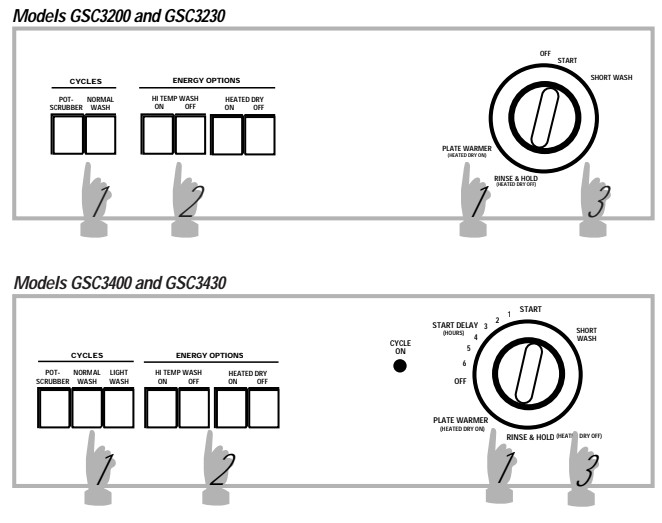
Control Settings
Cycles
- POTSCRUBBER: For heavily soiled dishes or cookware with dried-on or baked-on soils. Everyday dishes may be included. This cycle will not remove burned-on foods.
- NORMAL WASH: For loads of everyday dishes, glasses and cookware with medium soils. NOTE: Many dishes have lighter soil than normal. Choosing a cycle other than NORMAL WASH will save energy and water.
- LIGHT WASH: For dishes with light soils.
SHORT WASH: For quickly washing loads of everyday dishes with medium soils that have not dried on, such as loads consisting mostly of glasses. - RINSE & HOLD: For rinsing partial loads that will be washed later. Do not use detergent.
- PLATE WARMER: For warming clean dishes and serving plates. This cycle will take approximately 32 minutes.
Make sure the Dial is at the OFF position.
Latch the door.
Energy Options
- HI TEMP: Provides extra heat for best performance. It is used WASH best with heavily-soiled dishes.
- HEATED DRY: Turns the drying heater on for fast drying. This ON cycle will extend the time to your wash cycle.
- HEATED DRY: Shuts off the drying heat options. Dishes air dry OFF naturally and energy is saved.
Start
Slowly turn the Dial to the START position. Don’t turn it past the START position, or you could accidentally miss a rinse. There is a time delay between start-up and water fill so you will not hear any wash action right away.
About Dial Cycles
Short Wash
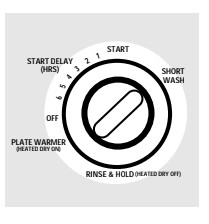
For quickly washing loads of everyday dishes with medium soils that have not dried on.
- Select the NORMAL WASH cycle and any options.
- Be sure the door is unlatched.
- Slowly turn the Dial to SHORT WASH.
- Latch the door to start the cycle.
Rinse & Hold
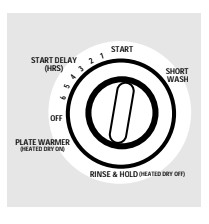
For rinsing partial loads that will be washed later. Do not use detergent.
- Make sure HEATED DRY OFFis selected.
- Be sure the door is unlatched.
- Slowly turn the Dial to RINSE & HOLD.
- Latch the door to start the cycle.
Plate Warmer
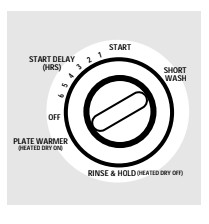
For warming clean dishes and serving plates. This cycle will take approximately 32 minutes.
- Load clean dishware to be warmed. Select HEATED DRY ON.
- Be sure the door is unlatched.
- Slowly turn the Dial to PLATEWARMER.
- Latch the door to start the cycle.
Start Delay (GSC3400 andGSC3430 only)
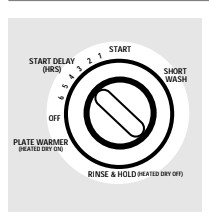
The START DELAY will allow you to delay the start time of any cycle not on the Dial automatically for up to 6 hours.
- Be sure the door is unlatched.
- Select the wash cycle and option you want.
- Slowly turn the Dial to desired time. The CYCLE ON light will come on.
- Latch the door to start the cycle.
| Cycle Sequence | |||
| Cycles | Water (approx.) | Time (approx.) | Cycle Sequence |
| POTSCRUBBER | 9.5gal. | 63min. | Rinse Rinse Rinse Main Wash Rinse Rinse Rinse |
| NORMAL WASH | 8.0gal. | 63min. | Rinse Rinse Main Wash Rinse Rinse Rinse |
| LIGHT WASH | 6.7gal. | 63min. | Rinse Rinse Main Wash Rinse Rinse |
| SHORT WASH | 6.6gal. | 55min. | Rinse Main Wash Rinse Rinse Rinse |
| RINSE & HOLD | 3.9gal. | 12min. | Rinse Rinse Rinse |
Drying Options:
- HEATED DRY ON: Available on all wash cycles except RINSE & HOLD. Add approximately 32 minutes to the cycle.
- HEATED DRY OFF: Drying heater is turned off. Dishes dry naturally.
Using the dishwasher.
Check the Water Temperature
The entering water must be at least 120°F. and not more than 150°F., for effective cleaning and to prevent dish damage. Check the water temperature with a candy or meat thermometer. Turn on the hot water faucet nearest the dishwasher, place the thermometer in a glass and let the water run continuously into the glass until the temperature stops rising.
Using a Rinse Agent
A rinse agent, such as JET-DRY, makes water flow off the dishes quickly thereby reducing water spotting
Fill the rinse agent dispenser until it reaches the bottom of lip inside the opening. Replace cap.
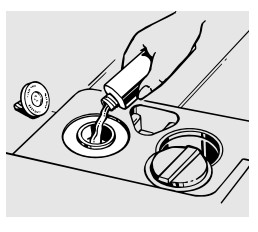
To check if rinse agent is needed, remove the cap and look into the dispenser. On some models, the dispenser can be checked by pressing the clear center of the fill cap 2 or 3 times. If rinse agent fills the center of the fill cap, you have enough.
A full dispenser should last about one month.
If rinse agent spills, wipe it up immediately. It can keep your detergent from working.
Forget to add a Dish?
A forgotten dish can be added any time before the detergent cup opens.
- Push the door latch to the left.
- Do not open the door until the water spray action stops. Steam may rise out of the dishwasher.
- Add forgotten dishes.
- Close the door and push the latch to the far right.
Proper Use of Detergent
Use only detergent specifically made for use in dishwashers. Keep your detergent fresh and dry. Don’t put powder detergent into the dispenser until you’re ready to wash dishes.
The amount of detergent to use depends on whether your water is hard or soft. With hard water, you need extra detergent. With soft water, you need less detergent.
Protect your dishes and dishwasher by contacting your water department and asking how hard your water is. Twelve or more grains is extremely hard water. A water softener is recommended. Without it, lime can build up in the water valve, which could stick while open and cause flooding. Too much detergent with soft water can cause a permanent cloudiness of glassware, called etching.
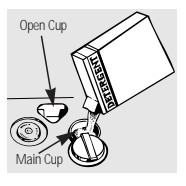
You’ll find two detergent dispensers on the door of your dishwasher. All wash cycles except RINSE & HOLD require detergent in the main cup. If your dishes have extra heavy soil or you have hard water you may want to add detergent to the open cup also. Wash cycles with two washes will also use the open cup.
Be sure the Dial is at OFF position before adding detergent. Otherwise, the detergent cup will not close and latch properly. Add detergent then close the main cup.
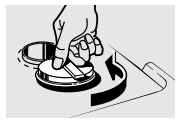
NOTE: To open detergent cup after it has been closed, simply turn the detergent cup handle counter-clockwise until it releases. A snapping sound may be heard.
Loading the dishwasher racks.
For best dishwashing results, follow these loading guidelines. Features and appearance of racks and silverware baskets may vary from your model.
Upper Rack
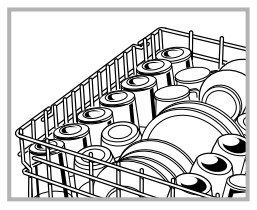
The upper rack is for glasses, cups and saucers. Cups and glasses fit best along the sides. This is also a secure place for dishwasher-safe plastics. The upper rack is good for all kinds of odd- shaped utensils. Saucepans, mixing bowls and other items should be placed face down.
- Secure larger dishwasher-safe plastics over two fingers When possible.
- Make sure small plastic items are secure so they cant’ fall onto the heating element.
The Wash Tower

Keep the center area clear in the lower rack. The wash tower rises through the center of the lower rack during the wash and rinse portions of the cycle.
Don’t block it or load tall things next to it. Also, be careful not to let a portion of an item such as a pot or dish handle extend through the bottom rack. This could block the wash arm and cause poor washing results.
Lower Rack
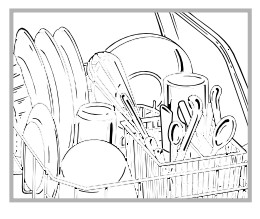
When loading the lower rack, do not load lagre platters or trays in the front right corner.They may prevent detergent from circulating during the wash cycle.
The lower rack is best used for plates, saucers, and cookware. Large items such as broiler pans and racks should go along the sides. Load platters, pots and bowls along the sides, in corners, or in the back. The soiled side of items should face the center of the rack.
Silverware Basket
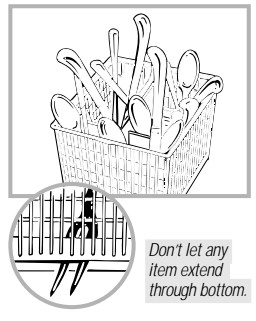
Put flatware in the removable basket with fork and knife handles up to protect your hands. Place spoons in the basket with handles down. Mix
knives, forks and spoons so they don’t nest together. Distribute evenly. Small plastic items, such as measuring spoons and lids from small containers, should go in the bottom of the silverware basket with silverware on top.

A security cell cover (on some models) hinged in some handles can be lowered to either side to secure lightweight items from the effects of the vigorous wash action.
Caring for the dishwasher
To clean the control panel use a lightly dampened cloth then dry thoroughly. To clean the exterior use a good appliance polish wax. Never use sharp objects, scouring pads or harsh cleaners on any part of the dishwasher.
Protect from Freezing
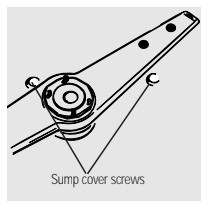
If your dishwasher is left in an unheated place during the winter, ask a service technician to:
- Cut off electrical power to the dishwasher. Remove fuses or trip circuit breaker.
- Turn off the water supply and disconnect the water inlet line from the water valve.
- Drain water from the inlet line and water valve. (Use a pan to catch the water.)
- Reconnect the water inlet line to the water valve.
- Remove the plastic sump cover in the tub bottom and use a sponge to soak up water in the rubber boot.
Does Your Dishwasher Have an AirGap?
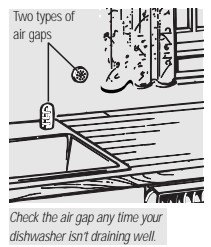
An air gap protects your dishwasher against water backing up into it if a drain clogs. The air gap is not a part of the dishwasher. It is not covered by your warranty. Not all plumbing codes require air gaps, so you may not have one.
The air gap is easy to clean.
Turn off the dishwasher and lift off the chrome cover. Unscrew the plastic cap and clean with a toothpick.
About optional accessories
You can change the door and lower access panel appearance of your dishwasher by ordering one of these optional accessories:
- Color Panels
- 1/4” Wood Panel TrimKit
- 3/4” Trimless Panel Kit
These accessories are available at extra cost (VISA, MasterCard, or Discover cards accepted) by calling 800-626-2002. Specify accessory number when ordering.
Descriptions of Optional Accessories
Color panels— Replacement door panels and lower access panels are available in the following colors:
- GPF300A (Almond)
- GPF300B (Black)
- GPF300W (White)
Woodpanel trimkit— This accessory contains trim and instructions for you to supply and install a 1⁄4 thick decorative wood door and lower access panel:
- GPF325A (Almond)
- GPF325B (Black)
- GPF325W (White)
NOTE: The GPF100 dishwasher door spring kit must also be ordered and installed when the door panel weighs four lbs. or more.
Trimlesspanel kit— This accessory contains parts and instructions for you to supply and install a 3⁄4 thick decorative wood door and lower access panel:
- GPF375
NOTE: The GPF100 dishwasher door spring kit will be included with the trimless panel kit and must be installed with it.
Before You Call for Service…
Troubleshooting Tips: Review the tips below first and you may not need to call for service.
Dishwasher won’t run
Fuse is blown, or the circuit breaker tripped
Replace fuse or reset circuit breaker. Remove any other appliances from the circuit.
Noise
Some of the sounds you’ll hear are normal
- Soft food disposal shredding action.
- Drain valve opening to pump water out.
- Timer control as cycle progresses.
- Detergent cup opening.
- The motor stopping during the drying period.
Utensils are not secure in the rack or something small has dropped into the rack
- Make sure everything is secured in dishwasher.
Motor hums
Dishwasher has not been used on a regular basis. If you do not use your dishwasher often, set it to fill and pump out once every week. This will help keep the seal moist and the garbage disposer clear.
| Problem | Possible Causes | What To Do |
| Water standing in the bottomof the tub | This is normal | • A small amount of clean water around the outlet on the tub bottom at the back of the tub keeps the water seal lubricated. |
| Water won’t pump out of the tub | Drain is clogged | • If you have an air gap, clean it. • Check to see if your kitchen sink is draining well. If not, you may need a plumber. • If the dishwasher drains into a disposer, run disposer clear. |
| Suds inthe tub | Correct detergent wasn’t used | • Use only automatic dishwasher detergents to avoid sudsing. •To remove suds from the tub, open the dishwasher and let suds evaporate. Add 1 gallon of cold water to the tub. Close and latch the dishwasher. Pump out water by slowly turning the Dial until a drain period is reached. Repeat if necessary. |
| Rinse agent was spilled | • Always wipe rinse spills immediately | |
| Stained tub interior | Detergent with colorant was used | • Some detergents contain colorant (pigment or dyes) that will discolor the tub interior with extended use. • Check the detergent cup for signs of any discoloration. If cup is discolored, change to detergent without any colorant. |
| Dishes don’t dry | Low inlet water temperature | • Make sure inlet water temperature is correct |
| Reinse agent dispenser is empty | • Check rinse agent dispenser | |
| Dishes and flatware not clean | Inlet water temperature is below 120°F. | • Raise the water heater temperature to 120°F. • Use the HI TEMP WASH option. |
| Water pressure is temporarily low | • Turn on a faucet. Is water coming out more slowly than usual? If so, wait until pressure is ormal before using your dishwasher. | |
| Air gap is clogged | • Clean the air gap | |
| Improper rack loading | • Make sure large dishware does not block the detergent dispenser or the wash arm | |
| Spots and filming on glasses and flatware | Extremely hard water Low inlet water temperature Overloading the dishwasher Improper loading Old or damp powder detergent Rise agent dispenser empty Too little detergent | To remove stubbor spots from glassware: 1.Remove all metal utensils from the dishwasher 2.Do not add detergent 3.Select the longest cycle 4.Start dishwasher and allow to run for 18 to 22 minutes. Dishwasher will now be in the main wash 5.Open the door and pour 2 cups (500ml) of white vinegar into the bottom of the dishwasher 6.Close the door and allow to complete the cycle. If vinegar rinse doesn’t work, repeat as above except use 1/4 cup (60ml) of citric acid crystals instead of vinegar |
| Cloudness on glassware | Combination of soft water and too much detergent | This is called etching and is permanent. To prvent this from happening, use less detergent if you have soft water. Wash glassware in the shortest cycle that will get them clean |
| Water temperature entering the dishwasher exceeds 150°F. | Lower the water heater temperature | |
| Yellow or brown film on insider surfaces | Tea or coffee stains | Remove the stain by hand, using a solution of 1/2 cup bleach and 3 cups warm water Before cleaning interior, wait at least 20 minutes safter a cycle for the heating element to cool down. Failure to do so can result in burns |
| An overall yellow or brown film can be caused by iron deposits in water | A special filter in the water supply line is the only way to correct this problem. Contact a water softener company | |
| White film on inside surfaces | Hard water minerals | To clean the interior, apply dishwasher detergent to a damp sponge. Wear rubber gloves. Do not use any type of cleanser other than dishwasher detergent because it may cause foaming or sudsing |
| Detergent cup lid won’t latch | Dial is not in the OFF position | Turn the dial to OFF and slide the door latch to the left |
| Detergent left in dispenser cups | Dishes are blocking the detergent cups | Reposition the dishes |
| Steam | This is normal | Steam comes through the vent by the door latch during drying and when water is being pumped out |
| Black or gray marks on dishes | Aluminum utensils have rubbed against dishes | Remove marks with a mild, abrasive cleaner |
Download the PDF version of this GE Dishwasher user manual here
